
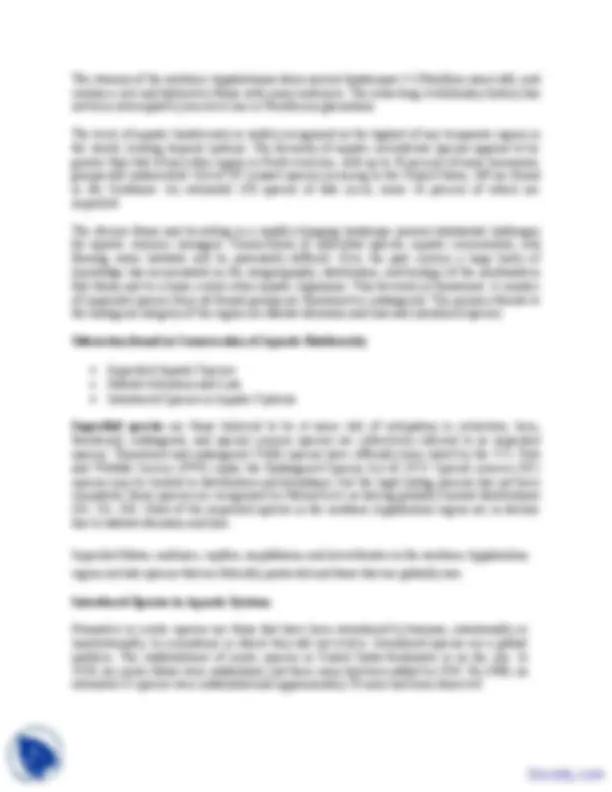
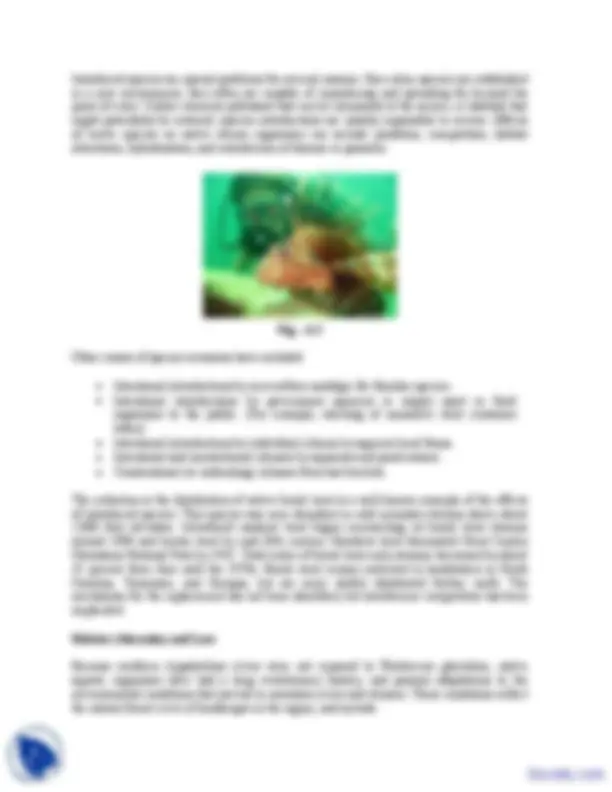
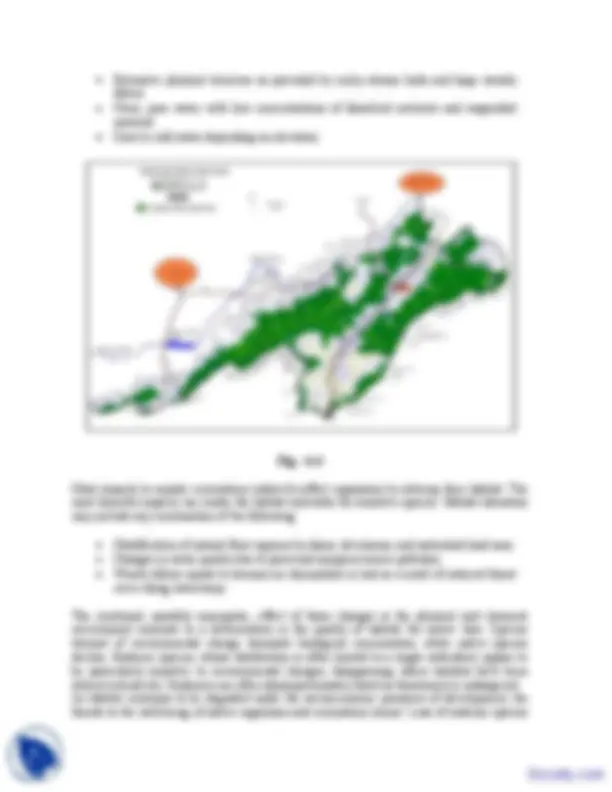
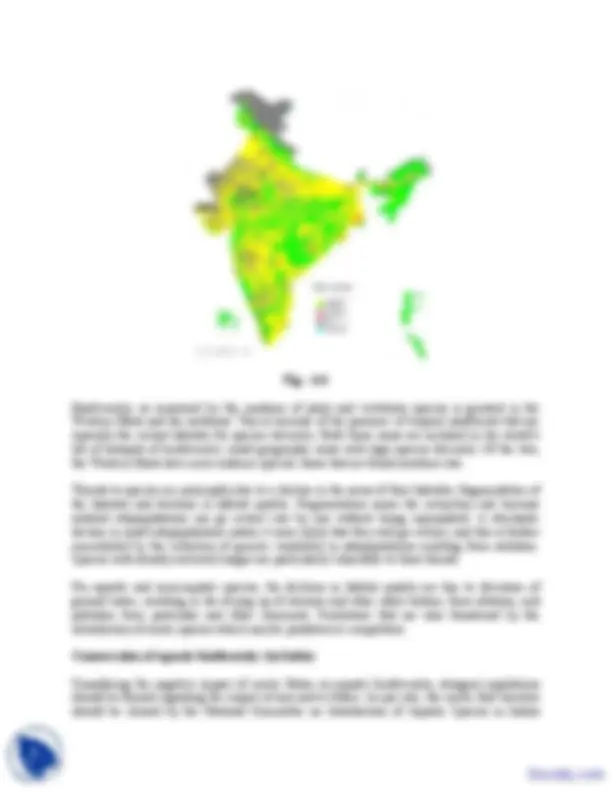
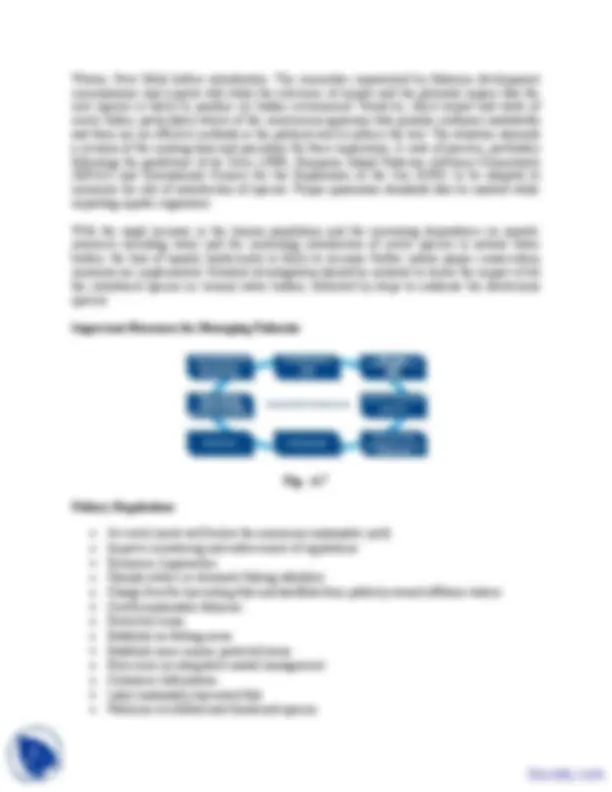

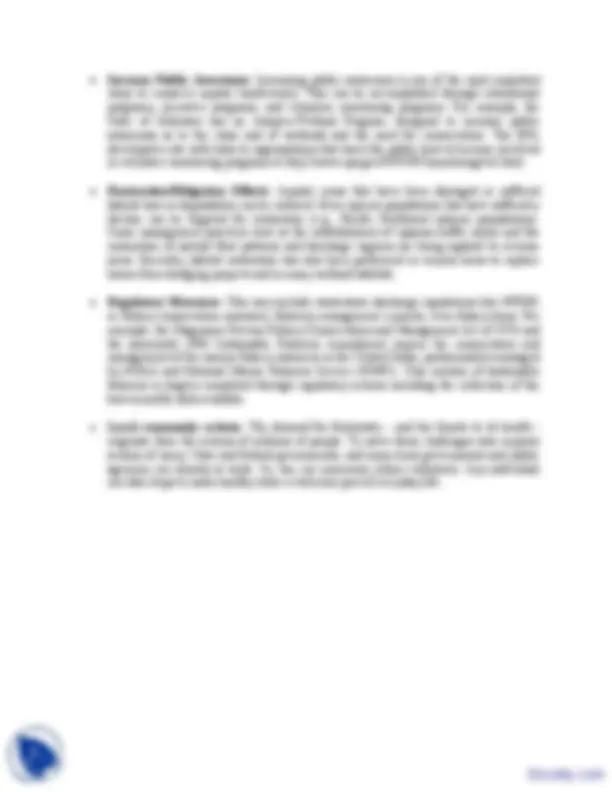


Study with the several resources on Docsity

Earn points by helping other students or get them with a premium plan


Prepare for your exams
Study with the several resources on Docsity

Earn points to download
Earn points by helping other students or get them with a premium plan
Community
Ask the community for help and clear up your study doubts
Discover the best universities in your country according to Docsity users
Free resources
Download our free guides on studying techniques, anxiety management strategies, and thesis advice from Docsity tutors
Environmental Sciences is sub category of Biology study. This lecture note is related to Environment Pollution subject. Main points in this lecture are: Management, Conservation, Aquatic, Biodiversity, Extinctions, Regulations, Imperiled, Habitat, Alteration, Species, Ecosystem, Approach
Typology: Study notes
1 / 13

This page cannot be seen from the preview
Don't miss anything!








Fig – 6.
INTRODUCTION
Aquatic biodiversity includes variety of life and ecosystems of freshwater, brackish water and marine environment. The human societies had long been depending upon aquatic biodiversity for food, medicine and other uses including commercial and industrial nature. The economic value of aquatic biodiversity is immeasurable and immense.
In recent times, the factors like over-exploitation, pollution, habitat alteration and destruction, introduction of alien species etc., are overwhelmingly causing impacts and threats to aquatic biodiversity.
There is necessity to put in place appropriate conservation strategies and actions to safeguard the aquatic biodiversity for the benefit of the present, as well as, future generations. The conservation oriented scientific pursuit and technology backed interventions would only address the pressing problems in protecting aquatic biodiversity and its sustainable use with the understanding of interdependence of organisms and ecosystems and human needs in the present day context.
Ecologically effective ecosystem management will require the development of a robust logic, rationale, and framework for addressing the inherent limitations of scientific understanding. It
must incorporate a strategy for avoiding irreversible or large-scale environmental mistakes that arise from social and political forces that tend to promote fragmented, uncritical, short-sighted, inflexible, and overly optimistic assessments of resource status, management capabilities, and the consequences of decisions and policies.
Aquatic resources are vulnerable to the effects of human activities catchment-wide, and many of the landscape changes humans routinely induce cause irreversible damage (e.g., some species introductions, extinctions of ecotypes and species) or give rise to cumulative, long-term, large- scale biological and cultural consequences (e.g., accelerated erosion and sedimentation, deforestation, toxic contamination of sediments). In aquatic ecosystems, biotic impoverishment and environmental disruption caused by past management and natural events profoundly constrain the ability of future management to maintain biodiversity and restore historical ecosystem functions and values. To provide for rational, adaptive progress in ecosystem management and to reduce the risk of irreversible and unanticipated consequences, managers and scientists must identify catchments and aquatic networks where ecological integrity has been least damaged by prior management, and jointly develop means to ensure their protection as reservoirs of natural biodiversity, keystones for regional restoration, management models, monitoring benchmarks, and resources for ecological research.
Conservation of Aquatic Biodiversity
Fig – 6.
Introduced species are special problems for several reasons. Once alien species are established in a new environment, they often are capable of reproducing and spreading far beyond the point of entry. Unlike chemical pollutants that can be eliminated at the source, or habitats that might potentially be restored, species introductions are usually impossible to reverse. Effects of exotic species on native stream organisms can include predation, competition, habitat alterations, hybridization, and introduction of disease or parasites.
Fig – 6. 3
Other causes of species invasions have included:
Intentional introductions by new settlers nostalgic for familiar species. Intentional introductions by government agencies to supply sport or food organisms to the public. (For example, stocking of nonnative trout continues today). Intentional introductions by individual citizens to augment local fauna. Intentional and unintentional releases by aquarists and pond owners. Unintentional (or unthinking) releases from bait buckets.
The reduction in the distribution of native brook trout is a well-known example of the effects of introduced species. This species was once abundant in cold mountain streams above about 2,000 foot elevation. Introduced rainbow trout began encroaching on brook trout streams around 1900 and brown trout by mid-20th century. Rainbow trout dominated Great Smoky Mountains National Park by 1942. Total miles of brook trout-only streams decreased by about 45 percent from then until the 1970s. Brook trout remain restricted to headwaters in North Carolina, Tennessee, and Georgia, but are more widely distributed further north. The mechanism for the replacement has not been identified, but interference competition has been implicated.
Habitat Alteration and Loss
Because southern Appalachian rivers were not exposed to Pleistocene glaciation, native aquatic organisms have had a long evolutionary history, and possess adaptations to the environmental conditions that prevail in mountain rivers and streams. These conditions reflect the natural forest cover of landscapes in the region, and include:
Extensive physical structure as provided by rocky stream beds and large woody debris. Clear, pure water with low concentrations of dissolved nutrients and suspended material. Cool to cold water depending on elevation.
Fig – 6. 4
Most impacts to aquatic ecosystems indirectly affect organisms by altering their habitat. The most harmful impacts can render the habitat unlivable for sensitive species. Habitat alteration may include any combination of the following:
Modification of natural flow regimes by dams, diversions, and watershed land uses. Changes in water quality due to point and nonpoint source pollution. Woody debris inputs to streams are diminished or lost as a result of reduced forest cover along waterways.
The combined, possibly synergistic, effect of these changes in the physical and chemical environment amounts to a deterioration in the quality of habitat for native taxa. Species tolerant of environmental change dominate biological communities, while native species decline. Endemic species, whose distribution is often limited to a single watershed, appear to be particularly sensitive to environmental changes, disappearing where habitats have been altered extensively. Endemics are often disproportionately listed as threatened or endangered. As habitat continues to be degraded under the socioeconomic pressures of development, the threats to the well-being of native organisms and ecosystems mount. Loss of endemic species
Fig – 6. The Government of Vietnam has issued laws and regulations concerning aquatic resources management and conservation, complemented by a number of measures to improve public understanding of the significance of aquatic biodiversity. However, further efforts are needed. The loss of aquatic biodiversity is attributed to several reasons, such as overfishing, use of chemicals and explosives to catch fish, construction of dams that bar access to spawning grounds, and poor planning to develop aquaculture, as seen in the recent boom in shrimp farming in coastal areas.
A national aquatic biodiversity conservation project (1996-2000) was a key component in the 1996 national action plan for biodiversity conservation. The project’s objectives were to set up ex-situ live gene banking for cultured freshwater species/strains and some indigenous species and to promote sustainable aquaculture. Live gene banking of freshwater species was initiated at three branches of the Research Institute for Aquaculture. A primary data bank provided information on karyotype and morphological features of most maintained species. Facilities were improved and staff training was conducted in cryopreservation, isozyme and DNA analysis for species/strain characterization. However, ex-situ gene banking poses some difficulties because of the large pond areas required and the need for quality feeds and appropriate stock management to maintain the quality of stocks.
The national aquatic biodiversity conservation project (2001-2005) provides for three major activities: (i) assessment of aquatic resources to identify threatened indigenous species and relevant holistic approaches for natural preservation and enhancement, (ii) live gene banking of aquatic animals with priority given to commonly cultured species/strains and seriously threatened indigenous species in both fresh and brackish water, and (iii) building up a gene data bank, including characterization of growth performance, breeding, karyotype and markers of isozyme and DNA.
In India:
Biodiversity is under threat worldwide. For example, the global mammalian extinction rate of 0.35% of species lost per century since 1600 is calculated to be between 17 and 377 times the mammalian background extinction rate during the past 65 million years, that is, since the mass extinction that removed the dinosaurs. India has considerable biodiversity that is under threat as the table below indicates:
Number of Indian species (Percent of world total)
Percent of Indian species evaluated
Species threatened in India as percent of those evaluated
Number extinct (percent of those evaluated)
Amphibians 207 (4%) 79% 57% unknown Freshwater fish
700 46% 70% unknown
Fig – 6.
Biodiversity, as measured by the numbers of plant and vertebrate species is greatest in the Western Ghats and the northeast. This is because of the presence of tropical rainforests that are typically the richest habitats for species diversity. Both these areas are included in the world’s list of hotspots of biodiversity: small geographic areas with high species diversity. Of the two, the Western Ghats have more endemic species, those that are found nowhere else.
Threats to species are principally due to a decline in the areas of their habitats, fragmentation of the habitats and declines in habitat quality. Fragmentation raises the extinction risk because isolated subpopulations can go extinct one by one without being repopulated. A stochastic decline in small subpopulations makes it more likely that they will go extinct, and this is further exacerbated by the reduction of genetic variability in subpopulations resulting from isolation. Species with already restricted ranges are particularly vulnerable to these threats.
For aquatic and semi-aquatic species, the declines in habitat quality are due to diversion of ground water, resulting in the drying up of streams and other water bodies, from siltation, and pollution from pesticides and other chemicals. Freshwater fish are also threatened by the introduction of exotic species which may be predators or competitors.
Conservation of aquatic biodiversity: (in India)
Considering the negative impact of exotic fishes on aquatic biodiversity, stringent regulations should be framed regarding the import of non-native fishes. As per rule, the exotic fish varieties should be cleared by the National Committee on Introduction of Aquatic Species in Indian
Bycatch
Use wide-meshed nets to allow escape of smaller fish Use net escape devices for sea birds and sea turtles Ban throwing edible and marketable fish back into the sea
Aquaculture
Restrict coastal locations for fish farms Control pollution more strictly Depend more on herbivorous fish species
Nonnative Invasions
Kill organisms in ship ballast water Filter organisms from ship ballast water Dump ballast water far at sea and replace with deep-sea water
Protecting Wetlands
Legally protect existing wetlands Steer development away from existing wetlands Use mitigation banking only as a last resort Require creation and evaluation of a new wetland before destroying an existing wetland Restore degraded wetlands Try to prevent and control invasions by nonnative species
Legal agreements and awareness
National and International Laws and Treaties to Help Protect Marine Species:
1975 Convention on International Trade in Endangered Species (CITES) 1979 Global Treaty on Migratory Species U.S. Marine Mammal Protection Act of 1972 U.S. Endangered Species Act of 1973 U.S. Whale Conservation and Protection Act of 1976 1995 International Convention on Biological Diversity.
What is the role of international agreements and protected marine sanctuaries?
The United Nations Law of the Sea says that all coastal nations have responsibility over the waters up to 19 kilometers (12 miles) from the shore. Also, they have jurisdiction over their Exclusive Economic Zone which extends 320 kilometers (200 miles) offshore.
Together, the nations of the world have jurisdiction to 36% of ocean surface, and 90% of the world’s fish stocks.
Instead of protecting the fishing grounds, many countries promote overfishing, subsided new fishing fleets, and have failed to establish or enforce stricter regulation of fish catches.
World Conservation Union
In 1986, they established a global system of of marine protected areas. A MPA is an area of ocean protected from some or all human activities. The 1,300 existing MPA provide partial protection for about .2% of the earth’s total ocean.
Marine Reserves
Also known as fully protected areas or no-take MPAs They are areas where no extraction and alteration of any living or nonliving resources is allowed More than 20 coastal nations have established marine reserves.
Conservation Strategies
Due to factors such as human modifications to the environment, overexploitation, habitat loss, exotic species and others, aquatic biodiversity is greatly threatened. Ecosystems and species important in sustaining human life and the health of the environment are disappearing at an alarming rate. In order to preserve these threatened areas and species for future generations, immediate action in the form of aquatic biodiversity conservation strategies are necessary.
In general, aquatic conservation strategies should support sustainable development by protecting biological resources in ways that will preserve habitats and ecosystems. In order for biodiversity conservation to be effective, management measures must be broad based. This can be achieved through many mechanisms including:
Aquatic Diversity Management Areas (ADMAs) : As first proposed by Moyle and Yoshiyama (1994) the creation of ADMAs, are a systematic management approach for watersheds, where the primary goal is to protect the aquatic biodiversity in a given area. ADMAs range from individual species protection acts to full-scale biodiversity oriented programs. The best way to properly manage ADMAs is to stop or greatly reduce all human activity contributing to habitat degradation in that area. This concept has been applied in the Sierra Nevada area.
Marine Reserves: A marine reserve is a defined space within the sea in which fishing is banned or other restrictions are placed in an effort to protect plants, animals, and habitats, ultimately conserving biodiversity. Marine reserves can also be used for educational purposes, recreation, and tourism as well as potentially increasing fisheries yields by enhancing the declining fish populations. Marine reserves are also very similar to marine protected areas, fishery reserves, sanctuaries, and parks.
Bioregional Management: Bioregional management is a total ecosystem strategy, which regulates factors affecting aquatic biodiversity by balancing conservation, economic, and
Increase Public Awareness: Increasing public awareness is one of the most important ways to conserve aquatic biodiversity. This can be accomplished through educational programs, incentive programs, and volunteer monitoring programs. For example, the State of Delaware has an Adopt-a-Wetland Program, designed to increase public awareness as to the value and of wetlands and the need for conservation. The EPA developed a site with links to organizations that teach the public how to become involved in volunteer monitoring programs at http://www.epa.gov/OWOW/monitoring/vol.html.
Restoration/Mitigation Efforts: Aquatic areas that have been damaged or suffered habitat loss or degradation can be restored. Even species populations that have suffered a decline can be targeted for restoration (e.g., Pacific Northwest salmon populations). Some management practices such as the establishment of riparian buffer zones and the restoration of natural flow patterns and discharge regimes are being applied to riverine areas. Recently, habitat restoration has also been performed in various areas to replace losses from dredging projects and in many wetland habitats.
Regulatory Measures: This may include wastewater discharge regulations like NPDES or fishery conservation measures, fisheries management councils, even fishery bans. For example, the Magnuson-Stevens Fishery Conservation and Management Act of 1976 and the associated 1996 Sustainable Fisheries Amendment require the conservation and management of the marine fishery resources in the United States, predominately managed by NOAA and National Marine Fisheries Service (NMFS). This creation of sustainable fisheries is largely completed through regulatory actions including the collection of the best scientific data available.
Local community actions: The demand for freshwater - and the threats to its health - originate from the actions of millions of people. To solve these challenges also requires actions of many. State and federal governments, and many local governments and public agencies, are already at work. So, too, are numerous citizen volunteers. Any individual can take steps to make healthy water a welcome part of everyday life.